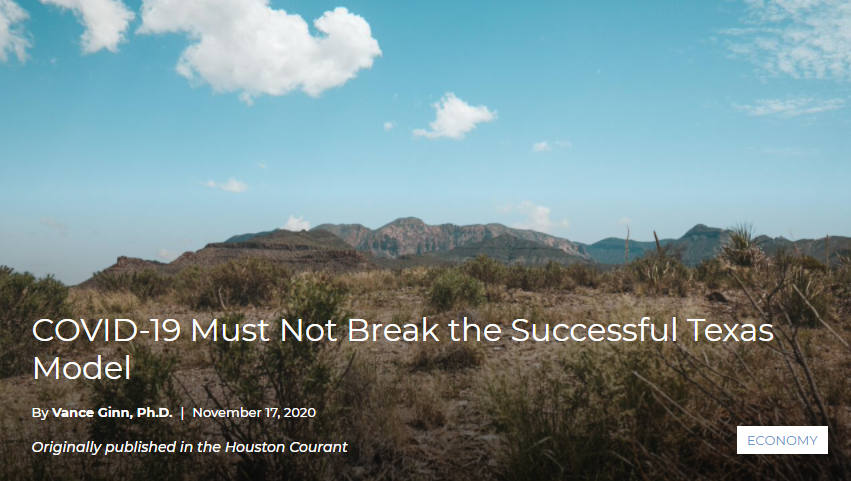|
Shutdowns and stay-at-home orders across Texas due to COVID-19 have spiked unemployment, slowed tax receipts, and forced the permanent closure of 8,900 Texas businesses since March. This, from one of the most dynamic and fast-growing economies in the world.
A return to previous success is possible, and necessary, by safely reopening Texas and promptly strengthening its institutions. The Texas Model of relatively limited government, along with the pro-growth policies of the Trump administration, provided an institutional framework that helped create an attractive economic environment to let people prosper. In 2019, Texas led the nation with GDP growth of 4.4% and with the most jobs added of nearly 350,000 (and the fourth-fastest growth rate of 2.7%). Also, Texas had the lowest supplemental poverty measure rate of 13.7%, (the SPM accounts for cost of housing differences across the nation and other key metrics), compared with other large states of New York (14.4%), Florida (15.4%), and California (17.2%)—the highest in the nation. In addition, the Texas model was strengthened by a voter-approved constitutional ban on a personal income tax last year, property tax relief through reform and reductions, and a track record over the last three sessions of passing conservative budgets. But these benefits couldn’t withstand the economic destruction of fear. Fear led the public to decrease their interactions early on during the COVID-19 pandemic, before state and local governments created a whiplash of openings and closures with questionable results. At the state level, Texas Gov. Greg Abbott issued a disaster proclamation on March 13, near the start of the pandemic, and then a stay-at-home order on March 31. Some restrictions were lifted on April 17 and more were eased a couple of weeks later before another the rise in COVID-19 cases and positive tests—both have been questionable measures to consider when making policy— over the summer raised concern, resulting in a statewide mask mandate and further restrictions. This sort of uncertainty makes it practically impossible for entrepreneurs to run a business or for job-seekers to find steady employment. The recently released GDP by state figures for the second quarter of 2020 accounted for this destruction. Dealing with a U.S. economy contracting by an annualized rate of 5% in the first quarter and 31.4% in the second, Texas’s GDP shrank by a record-breaking 29% in the second quarter. But this put it in the second quintile of best-performing states, if contracting at a record annual pace can be considered “best,” with less loss than Florida (-30.1%), California (-31.5%), and New York (-36.3%). While the third quarter growth improved dramatically across the U.S., the same is true in Texas as some restrictions were eased. And on Sept. 17, Texas changed the metric used to evaluate the situation to COVID-19 hospitalizations as a share of all hospitalized patients, which aligns with the initial reasoning for government overreach to avoid overwhelming hospital capacity. This allowed some trauma service areas (TSA) with that metric below 15% for seven consecutive days to open most businesses to 75% capacity. Then, on Oct. 7, a new Executive Order was issued that changed the metric to COVID-19 hospitalizations as a share of total hospital capacity, an improvement that better accounts for the flexibility that hospital managers have with beds. This order also expanded most businesses capacity to 75% in TSAs with less than 15% of this metric and allowed bars to open to 50% capacity—assuming a county’s judge approves it, which hasn’t been the case in most large urban counties. The new metric results in only three (Amarillo, Lubbock, and El Paso) of 22 TSAs with a hospitalization rate above 15%, as of Nov. 9, meaning that 94% of Texans can have access to 75% of certain business capacity. As COVID cases rise once more during flu season, calls for a second round of harsh restrictions are sure to happen. What these demands fail to understand is that the re-opening measures in place are not due to a blind indifference to human suffering, but rather a different, better path to evaluate tradeoffs. In addition, the catastrophic drop in GDP across the state was due in no small part to the swinging pendulum of shutdown to rollback to shut down again, with unemployment rising to a historically high 8.3%. Another statewide shutdown would deal another staggering blow to an economy recovering from the fallout of the pandemic. The Texas Model was responsible for the economic boom before the pandemic, and what comparative success we’ve had during the COVID-19 crisis was due to efforts to roll back restrictions in line with that model. If the state is to fully recover, the next steps to do so must be made clear soon as without it the uncertainty and fear will contribute to more job losses and the demise of the once successful Texas Model. https://www.texaspolicy.com/covid-19-must-not-break-the-successful-texas-model/ Comments are closed.
|
Vance Ginn, Ph.D.
|


 RSS Feed
RSS Feed